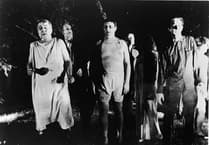WITH the 100th anniversary of the Armistice that ended the First World War approaching, the Forest of Dean Local History Society has published a detailed study of life in the area during those four tumultuous years.
The book, The Forest of Dean at War: Life in the Forest of Dean During World War One, has its roots in a project started in 2013 to study the home front locally.
A team of volunteers used documents at the Gloucestershire Archives and copies of the Dean Forest Mercury from the time and their labours were exhibited at the Dean Heritage Centre in Soudley for three months in 2014.
From there, the society decided to extend the project into producing a book with the project members being invited to extend their essays with the addition of material from the large archive of material on the First World War in the Dean contained in its award-winning journal, The New Regard.
There are 23 essays, including a preface by Keith Walker, on topics as diverse as the conscription of miners, the cable works at Lydbrook, the battalion of the Glosters – the 13th – raised in the Forest, the Dilke Hospital X-ray machine and DORA – the Defence of the Realm Act – a civilian version of martial law.
Virtually all aspects of life in the Forest are covered including work and family life, the community response to those such as the wounded and Belgian refugees, the war effort and the many rules and regulations.
Society treasurer Cecile Hunt, who also penned some of the essays, said: “The book is a mixture of essays, some are short, some are long and there are all sorts of interesting snippets.
“We wanted to tell the story of what has been forgotten — it is surprising what went on in the Forest.”
Christine Martyn’s survey of life in the Forest between 1914 and 1918, which first appeared in The New Regard in 2005, is one of the longest essays and gives a wide-ranging overview of what was happening at the time.
The Defence of the Realm Act might sound quite remote but Kate and Peter Ellis’s piece on ‘DORA’ shows it hit where it would hurt many Foresters – in the pub.
The government was very concerned about the impact of drunkenness on the war effort, with many workers spending the extra cash they earned through longer hours and overtime at the local.
The Dean was one of the selected areas which came under the watchful eye of the Liquor Traffic Central Control Board meaning restrictions on opening hours and locals having to pay more for weaker booze.
The battle to feed the nation and the pressure on farmers locally to produce more food is the subject tackled by society chairman Simon Moore.
In Gloucestershire, the county education authorities came in for criticism – although they saw “no reason to regret their action” – in allowing under age boys to take the place of farm workers who had gone to the front.
The education committee was less impressed by reports that some farmers were taking advantage by underpaying the boys, insisting that “under no circumstances” should the lads be paid less than five shillings a week.
The Volunteer Training Corps was the “Dad’s Army” of the First World War with a presence in Bream, Cinderford, Coleford, Longhope and Lydney.
These local defence units, made up of men older than 40, are discussed by Keith Walker who also looked at the local drive to fund the war effort and local charitable groups which ranged from the Bream Belgian Refugees’ Fund to the Lydney Men’s Own Tobacco, Parcels and Comforts Fund.
For a brief period after the start of the war, the Forest was potentially the sole supplier of acetone which was a key constituent of explosives.
Roger Deeks’s essay, first published in The New Regard in 2010, on the wood distillation works near Coleford, shows the factory was an important supplier of acetone throughout the war.
First published in 2005 in The New Regard, an article by Sam Eedle relates the remarkable story of the raising of the 13th battalion of the Gloucestershire Regiment in the winter of 1915 in the Forest – “the first and only time in its history the community raised its own battalion to fight in a major war.”
Many families waved off several of their menfolk to the front, some of whom were not to return. Dave Tuffley tells the stories of men from two sides of his family, the Tuffleys and the Bowketts whose experience was typical of many.
Another family story is related by Teresa Powell and concerns Walter Price of Newnham who was awarded the Distinguished Conduct Medal for his bravery in repairing a track that had been blown out, cutting off an ambulance train of wounded men.
Five sons of Thomas Joseph of Clanna served in the war with three of them killed and another losing a leg. David Reade’s article first appeared in The New Regard in 2010.
The ‘comb out’ of miners into the army – and the opposition to conscription – is Ian Wright’s first subject, both the personal stories and the political fall-out. He also looks at the 28 Forest men who applied to be excused military service on the ground of conscience.
Mary Sullivan looks at the role of women in the war – such as volunteering for the Red Cross and making items to send to local soldiers.
But they also paid a heavy personal price with many going hungry so that men and children would be fed first.
Women also played a direct and crucial role in the war effort, such as those at the cable works in Lydbrook where 70,000 miles of field telephone lines were produced. At its height it employed 650 people. Sue Gordon-Smith traces its history.
Cecile Hunt describes the “extraordinary” scenes in Cinderford on Saturday, October 17 when a group of Belgian refugees arrived and the other ways in which the Forest responded to the fall-out of the war.
By the end of the war there were 22 voluntary hospitals across Gloucestershire including Lydney and St Briavels. This network of hospitals treated more than 10,000 patients in 1918, the essay by Keith Walker reveals.
The last section of the book details war memorials around the Forest, including the X-ray unit at the Dilke hospital while Eric Nicholls and Roger Deeks relate the extraordinary story of the gates erected in memory of Private Reginald Packer at St Stephen’s Church in Cinderford – one of the country’s earliest memorials to an individual.
The 280-page book ends with an index of every individual and place mentioned.
The book, which is published by Holborn House of Blakeney and is for sale at £15, was supported by the Midcounties Co-op which has allowed the society to present every school in the Forest with a copy.




